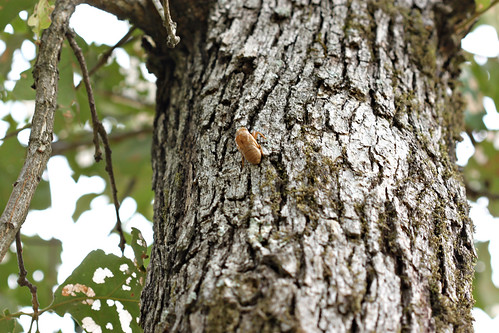
Looked up in the tree and saw another:

I decided this must be the year of the locust. So I came inside and googled year of the locust.....first line of the article was, Do not call Cicada locust. They are not locust!
I wonder if it would be acceptable to call them Katydid? That's what we always called them/ha
I remember being a Brownie Scout and our meeting place was a little building in the middle of many pine trees. The year the katydids came we all had a race to see who could collect the most from the trees. We had so much fun. The pine trees were covered with them.
From Wikipedia:
The nymphs of the periodical cicadas live underground, often at depths of 30 cm (1 ft) or more, feeding on the juices of plant roots. They stay immobile and go through five development stages before constructing an exit tunnel in the spring of their 13th or 17th year. These exit tunnels have a diameter of about 1–1.5 cm (0.4–0.6 in).
The nymphs emerge on a Spring evening when the soil temperature at about 20 cm (8 in) depth is above 17 °C (63 °F). In most years, this works out to late April or early May in far southern states, and late May to early June in the far northern states. Emerging nymphs climb to a suitable place on the nearby vegetation to complete their transformation into an adult cicada. They molt one last time and then spend about six days in the leaves waiting for their exoskeleton to harden completely. Just after this final molt, the teneral adults are white, but darken within an hour.
Adult periodical cicadas live only for a few weeks—by mid-July, all have disappeared. Their short adult life has one purpose: reproduction. The males "sing" a species-specific mating song; like other cicadas, they produce loud sounds using their tymbals. Singing males of a single Magicicada species form aggregations (choruses) that are sexually attractive to females. Males in these choruses alternate bouts of singing with short flights from tree to tree in search of receptive females. Most matings occur in "chorus" trees.
Receptive females respond to the calls of conspecific males with timed wing-flicks, which attract the males for mating. The sounds of a "chorus"—a group of males—can be deafening and reach 100 dB. In addition to their "calling" or "congregating" song, males produce a distinctive courtship song when approaching an individual female.
After mating, the female cuts V-shaped slits in the bark of young twigs and lays approximately 20 eggs in each, for a total of 600 or more eggs. After about six to ten weeks, the eggs hatch and the newborn nymphs drop to the ground, where they burrow and begin another 13 or 17-year cycle.
Pretty amazing I think.
The ones I am hearing belong to Brood XIX, The Great Southern Brood: AL, AR, GA, IN, IL, KY, TN, LA, MO, MS, NC, OK, SC, TN, VA.
If you hear them (and believe me you will, if they are in your area) take the kids out and teach them about the Cicada....it will be 13 years before they reappear!
11 comments:
Interesting! I've been hearing them around here too...might want to include TX in your reference.
Hope you are staying cool! Thanks always for stopping by. I so wish you had an email addy! :-)
xo
Pat
I have not heard any yet...but I have always loved that sound. We will look if we hear them. Thanks for all the info.
Love your wee one walking down the road and of course the farmer market made me want tomatoes.
Would you believe our plants only have small ones and the zucchini is only baby size.
Wow...that was interesting! We only get an occasional one...nothing like you guys in the southern states. One is loud enough...I can't imagine what hundreds of them sound like!
The sound is kinda cool...but they are SOOOOOOO ugly! YUK!
I really like the sound of katydids. :))
Luckily, the Cicadas have not visited us this year. They were in the Smokies --and have been in many other areas, but not here...
Have a good weekend.
Hugs,
Betsy
magical visitors!
Aloha from Waikiki;
Comfort Spiral
><}}(°>
> < } } ( ° >
We always called them locusts when I was growing up. I recently googled them and realized that locusts actually look more like grasshoppers. Who knew! We used to climb the trees and catch the cicadas. I was 12 -- would collect the little shells they left behind. My 12 year old can't stand the cacophony that bugs make at night. It's certainly not music to his ears. Ha! have a wonderful weekend. Tammy
We took LM for a walk the other night and I told him to stop and listen to the cicadas. Wish I had had this info then!
lol I did a post on them also....we always called them locust....I found a ton of their former selves all over the place...you can hear them in the trees at night....playing their song...
I hear cicadas every year! They are always the sound of August to me as it is always around August that I first hear them, although I've heard a few the past few days. I guess we have some that are on different and varying cycles. They are weird little buggers, aren't they :)
Post a Comment